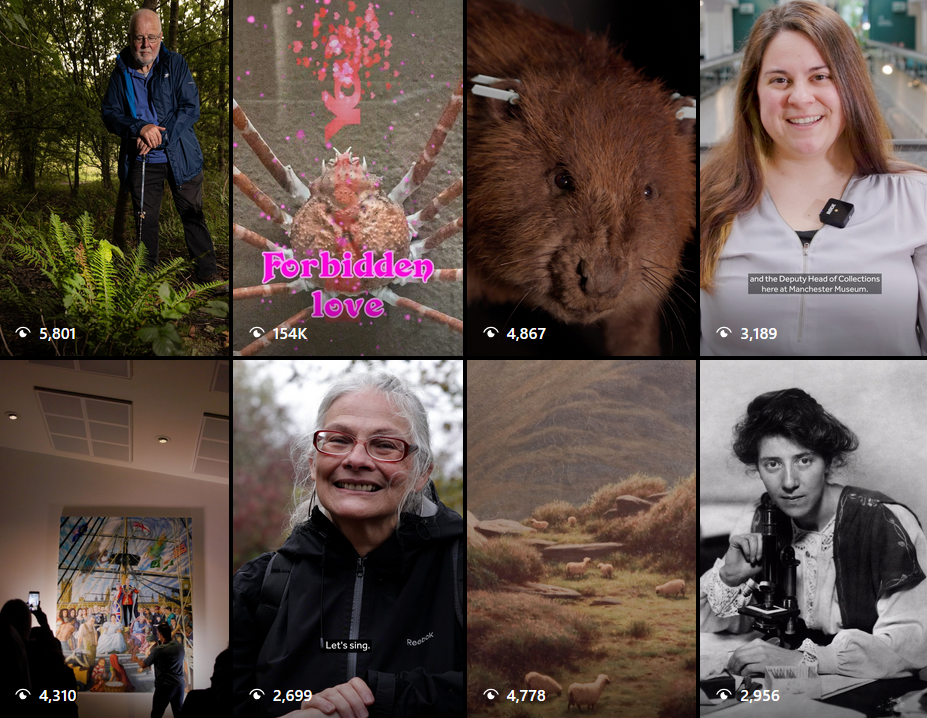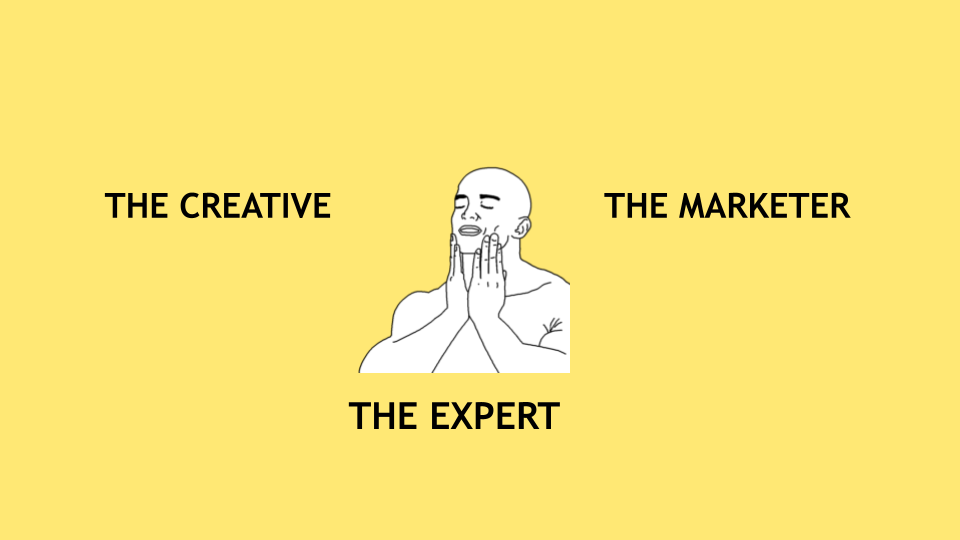May 2, 2025
Content of the week #16: Crabs crabs crabs crabs crabs crabs crabs
Natural history museums love their cornerstone objects. There’s the T-Rex. The whale skeleton. And the Japanese Spider Crab.
One particular Japanese Spider Crab (henceforth ‘The Crab’) sits in a glass case set into the front of Manchester Museum. Of all the cornerstone objects, this is is the most John-Carpenter’s-The-Thing-When-The-Guy’s-Head-Falls-Off-And-Grows-Legs-Crab creature known to science.
It’s the only organic thing in an otherwise blank and stony facade – frozen in contemplation of the busy Oxford Road – and its prominent weirdness makes it a natural mascot for the museum. (as an undergraduate it was a tradition to greet The Crab on the way back home from town.)
So it makes sense that Manchester Museum have made The Crab the star of a series of posts engaging with the weird, surreal and funny edge of TikTok and Instagram Reels.
Weird content has thrived since the internet was a thing, the endpoint for memes which combining the humour of Terry Gilliam, the trippiness of noughties Cartoon Network shows, and the lived experience of 4chan and Tumblr threads. The style can only be described as ‘Graphic Design is my Passion‘ – where people have the professional tools but choose to use them badly.
But the visuals aren’t enough – they still have to be funny and they still have to present something relatable, and at the core of the museum’s crab content are universal narratives we can buy into. There’s a protagonist – The Crab – and there is a situation, whether that’s DJ’ing a museum rave or a romantic relationship with Liverpool World Museum’s own Japanese Spider Crab. It’s content very much in the vein of RSPB’s Bird of the Week.
The latest video shows it’s what the audience crave, sitting at over 100k views while more traditional talking head videos languish at 4k.

So what does that tell us? It tells us that shitposting has an audience, offering another entry point into museums for people who may or may not be into history, heritage and science. It tells us that humanising the museum through talking heads and vox pops is all well and good, but what most people still really want from the internet is something entertaining.
The content is created by Tobias Longmate, Digital Content Creator at Manchester Museum, and I caught up with Head of Communications Connor Murphy to find out why they’re making crab videos, and more importantly how to create the conditions to allow weird to happen.
What he had to say isn’t groundbreaking, but if anything that’s actually quite reassuring. We already know the ingredients of successful social media – the difficulty is making the conditions for it.
Have the right people
This is still the most critical thing. Any strategy can say that you’re going to create funny, weird content that appeals to people on social media, but if you don’t have people who can put that into action your strategy may as well say that you want to make gold from lead.
I’ve written before that good social media requires three skillsets/experiences: the creative, the subject expertise, and digital marketing. Tobias simply has the sense of humour, the creative ability and the knowledge of the museum to create content that works for the internet.
But it’s not just the people at the coalface of content, it’s also the people who let them cook. Director Esme Ward sets the tone and the strategy of the museum as a whole – more public-facing, more responsive and more attuned with communities. Connor as Head of Communications also runs his team in a way that allows experimentation, who are honest and constructive when things aren’t working and willing to take (calculated) risks.
It also requires having the courage of your convictions. We have to be brave to not just say to people that their milk-toast posts aren’t going to cut it on the internet, but also to show why through data, examples and experience.

Tone of voice
Like a lot of museums, Manchester Museum took a long while to break out of the traditional tone of voice. The transition from broadcast marketing to interactive/adaptive social media content and community management requires a lot of trial and error.
But sometimes you also just need a decisive break.
In Manchester Museum’s case this was also a consequence of its real-world reputation. It lives in a Victorian Alfred Waterhouse building sat within an equally grand university campus. Before its recent redevelopment, the front door was even hidden away behind the frontage through an imposing archway.
The new entrance on Oxford Street reflects the new tone of voice – open to the public. If you’re trying to be inviting and bringing people in, that goes the same for online.
That new tone of voice may have to be balanced against the museum’s wider purpose. You may in fact want to still be quite serious and academic. But in Manchester Museum’s case it meant being more human.
Learn what people respond to
Connor and his team knew that their content was previously too broadcast and too impersonal, so they set out to make it more human and narrative-driven.
Their first attempts centred on the museum’s staff through a series of talking head videos, but they fell a little flat. They realised people want to connect with the museum, but having a human face on a video wasn’t enough – instead, they wanted to connect with narratives and experiences that spoke to them.
It sounds like an obvious thing to say, but how you translate that into content is anything but obvious. Luckily, though, they have the crab – a cornerstone object which everyone who visited the museum knows, which is popular with kids and is enough of an interesting object in itself to connect with new audiences.
But that doesn’t just mean doing a basic post or video about the crab, what it is, where it came from and all the usual stuff. People can get that in the museum.
Instead they adapted the crab to a format that works on the internet – giving it stories, giving it a personality, using intentionally naff editing and effects that reflect the kind of content which does well on Reels and TikTok. And by giving it an episodic narrative it gives people something to connect with and come back for.
And that’s pretty much it
Like I said, it’s not rocket science.
But having the right people in place, building good habits within both your team and the wider museum, and then having the creativity to create weird content is not easy. It requires trial and error, it requires honesty and it requires courage knowing that you’re headed in the right direction.
What else I’m thinking about
I’ve been doing a bit more work in theatre, including an interim role at the Young Vic (partly the reason these posts have been anything but weekly).
It’s given me a huge respect for people working in content and marketing to theatres. Instead of having a digitised collection and subject area to dip into for content, it’s almost entirely reliant on the strength, cast and restrictions around whatever show is playing.
The audience actually do need a fair amount of broadcast marketing, otherwise they don’t know what show is on, but your toolkit for expanding your audience through entertaining content relies much more on your own creativity, reactivity, knowing your community and making much more of behind the scenes.
(PS, I also have capacity coming up from July. If you need training, strategy, production or just some advice pls get in touch)
Reach out
Interested in what I do and how I can help? Chatting to me is free, and I can work to your budget :)
